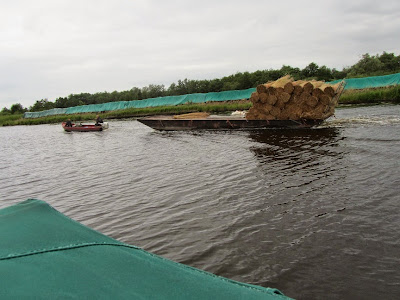From Widje Blik, we turned right towards Hilversum, then right again to find this charming lock, which we had to work ourselves. It is very unusual in The Netherlands to do your own work! This led on to a small canal, which in turn led on to the Loosedrechtsche Plassen.
This is a large lake, with many small islands. We had to follow a line of these islands to get to the sluis on the other side, but turned too soon, on entering the lake, and then managed to get completely lost! We hailed a passing cruiser, and they put us right, though the route they gave us took us rather too close to these racing yachts.
Eventually we reached the lock, sharing it with eight small boats. Do the crowd of gongoozlers ( non-boaters who idle their time away watching boats) remind you of Foxton Locks in England on a Sunday?
This staithe was the only type of mooring available on this part of The River Vecht, with no land access. Shannon did not approve!
At Muiden we followed the Vecht past many marinas. This jachthaven is The Royal Netherlands Sailing and Rowing Club, and is the home of the Royal Yacht, De Groene Draeck, but sadly we did not see it!
Then it was out on to the Ijmeer, on a lovely calm day. By taking the inner route, we avoid commercial traffic on the first part of this wide water, which leads to the south of Flevoland. The polder which is Flevoland was created out of part of the Zuider Zee in the 1950's. Our route takes us along the Randmeren, a well buoyed channel through the various meers which separate the mainland from Flevoland. Having first crossed Gooimeer, we head right in Eemmeer, and on to the River Eem.
This was a better mooring on the River Eem, both for us and for Shannon.
The barge Cascade was one of at least six passing our mooring that evening, all carrying sand or earth for dyke improvement. It makes all our boats look small, when some of these barges carry up to 1000 tons.
On Wednesday it was on into Amersfoort, where the Koppelpoort seen here dates back to the year 1400.
Amersfoort is the second largest town in the Utrecht province. We visited the Mondriaanhuis art gallery, as well as the Museum Flehite, which told the history of the town. Both of them were very interesting, in different ways.
Sint Joriskerk, or St. George's Church, dominates the main town square. The small roofed area in front of it is still the site of the fish market.
This street claims to be the best street in Amersfoort. Sally is making mosquito curtains for the windows, and we bought our final Velcro for these here. It was a fascinating shop, selling absolutely anything that could be needed for sewing. We get the impression that the Dutch do a lot of dressmaking.
While we were in Amersfoort a local reporter interviewed us for an article in the local paper. This is his picture to accompany the article.
Leaving Amersfoort, the Fietsboet overtook us, then we both met a fully laden barge, Fiat V Luntas. The gunnels of the barge are nearly underwater, due to the heavy cargo of sand. The Fietsboet is a cycle ferry, which can hold up to 125 people, presumably all with their bikes. It goes up and down the River Eem from Amersfoort, then out into the Randermeer to other towns too.
At another riverside mooring, the barge Cascade seemed to be very close to our window! We are getting used to these emormous barges.
The reason for all this barge traffic on the River Eem just now can be seen here. They are transporting the earth needed to strengthen the dyke all along this section of the river.




















































